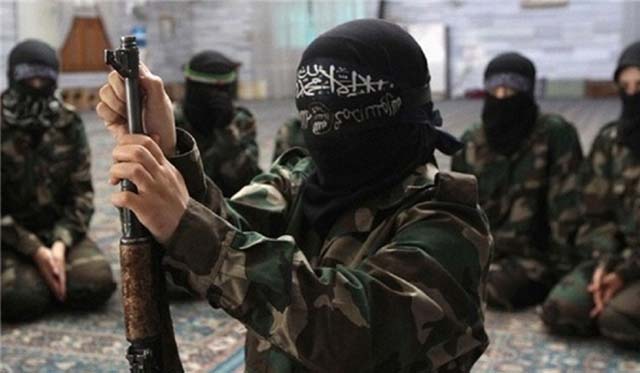The self-proclaimed Islamic State in Iraq and Levant (ISIL) maintains highly fundamental ideology. It ushered in merciless killings and systematic sexual practices in Iraq and Syria from the very beginning. The UK-based Syrian Observatory of Human Rights reports that ISIL executed at least 91 people across Syria within a period of one month, including 39 people from its own ranks. It adds that at least 32 civilians, including two women, were among the executed. There were also 11 fighters from different rebel groups and nine members of Assad’s troops among them, it said.
Since the declaration of its so-called “Islamic Caliphate” in June last year, ISIL has executed 182 of its own members who had been captured trying to flee the group and return home, the Observatory said. Additionally, ISIL executed 1,841 civilians, including 76 children and 95 women, over the past year by shooting, beheading, stoning, throwing off from high buildings and burning to death.
Based on its radical ideology, ISIL has gone about systematizing rape, sexual assault and slavery by embedding the buying, selling and gifting of slaves into a system of rewards for its fighters. Of the estimated 3,500 Yazidi women held by ISIL, survivors report being interrogated and in some cases stripped for sorting and categorizing. They have been rated according to desirability, labeled and transported across ISIL-held territory. They have been traded between fighters, and awarded by leadership as prizes.
Fundamentalism is deeply embedded in the minds and hearts of the ISIL group – which has transcended moral and religious restrictions. The ISIL’s radical ideology is likely to have surpassed the Taliban and al-Qaeda’s dogma. With the very emergence of the ISIL group, al-Qaeda leader Aymen al-Zawahiri rebuked its practices on the grounds of being extremely fundamental – when the videos of brutal killings were posted on public websites. Similarly, earlier this month the Taliban condemned a “horrific” video that apparently showed IS fighters blowing up bound and blindfolded Afghan prisoners with explosives. “This un-Islamic act... can never be justified,” the Taliban said.
Reportedly, ISIL seeks to gain stable foothold in Afghanistan. The sporadic abductions of travelers belonging to ethnic minorities by unknown gunmen – mainly the abduction of 31 passengers from a bus in the southern Afghan province of Zabul in late February which was intended to foment sectarianism – were believed to be carried out by the Islamic State (IS) group. “In Iraq and Syria, you might say (IS) are in stage six or seven or eight,” top US military officer General Martin Dempsey said last month. “In Libya, they are in stage three or four, and in Afghanistan they are in stage one or two.”
His views are echoed by other NATO officials who say that IS in Afghanistan are not yet capable of carrying out the sort of coordinated operations they are conducting in Iraq and Syria, although the potential exists for them to evolve into a bigger threat.
In spite of the IS’s hardline ideology, a number of the Taliban insurgents, particularly in the restive eastern provinces of Kunar and Nangarhar, have adopted the IS flag to rebrand themselves as a more lethal force as NATO troops depart after 14 years of war.
Michael Kugelman, Afghanistan expert at the Washington-based Woodrow Wilson International Center for Scholars, said Islamic State is the “flavor of the month right now. It has a dramatic appeal to a lot of alienated militants.”
But the Taliban are attempting to counter that, with an aggressive drive north from their southern and eastern strongholds, as well as a wave of fatal bombings in the Afghan capital, Kabul. Experts say the escalating violence demonstrates Mullah Mansour’s bid to boost his image within the Taliban, which could halt the defections to IS.
US drone strikes in recent weeks have also dealt a significant blow to IS in Afghanistan, killing dozens of suspected cadres, including the group’s Afghanistan-Pakistan regional chief Hafiz Saeed – this also shows the IS’s active presence in the country.
NATO spokesman Colonel Brian Tribus is cited as saying that IS is an “operationally emergent” group but the Taliban pose a “greater threat” to the Afghan government and foreign forces. It is crystal clear that the Taliban’s power and influence are far more formidable than the newly emerging group of IS. However, the allegiance of some Taliban militants strengthens IS and widens its realm of power in Afghanistan. Is it a matter of concern of Afghan officials?
There are also reports about the sporadic clashes between IS and Taliban militants in restive parts of the country. In other words, their ideological conflicts have led to serious tensions which narrow IS’s sphere of influence. But the government has to take defensive measures to prevent IS from gaining firm footholds in the country so as not to change Afghanistan into second Iraq – it is greatly feared by the public. In case of the IS’s strong influence in the country, all the investments made by western countries and international community in Afghanistan will be in vain. After all, the sacrifices made by foreign forces and Afghan civilians and police will be nil. It would be a serious threat to the Afghanistan’s nascent democracy. Likewise, the social, cultural and political investments such as achievements regarding women’s rights and their active participation in state positions, etc. all will be wasted. The world has to join forces to root out IS not only from Afghanistan but from the region otherwise it will pose menace to the entire globe.

